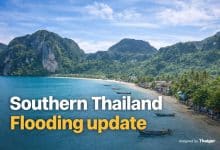Mekong floods prompt calls to halt Pak Beng Dam project

Floodwaters from the Mekong River have surged over its banks, affecting agricultural areas and prompting calls for the Thai government to review water management plans and delay the construction of the Pak Beng Dam.
Yesterday, August 25, it was reported from the banks of the Mekong River in Chiang Khong district, Chiang Rai province, that water levels continue to rise due to the release of water from dams in southern China and ongoing rainfall in the Mekong Basin.
At 9am, the water level in Chiang Khong district reached 10.6 metres, beginning to overflow into riverside areas. Agricultural lands are extensively flooded, exacerbated by water flowing from the Phayao Reservoir via the Ing River into the Mekong. This accumulation of water has led to significant flooding in areas along the river.
Jirasak Intayos, a coordinator for the Rak Chiang Khong group noted that the Mekong River’s behaviour has changed drastically over the years. Historically, the river’s water levels would rise during the rainy season and fall during dry periods, creating a natural cycle that sustained local ecosystems and communities.
However, the construction of 12 dams in China’s Yunnan province has disrupted this pattern, causing unpredictable fluctuations in water levels and diminishing the river’s ecological services, such as fish populations, said Jirasak.
“Today, we see outsiders turning the Mekong River into a commodity, building dams for profit under the guise of clean energy while destroying the environment and the lives of millions. Tourism cannot thrive on such destruction.”
River degradation
He emphasised that the Thai government and other Mekong countries have not adequately addressed the river’s degradation. If current trends continue, the Mekong might not recover.
The overflowing Mekong River in Chiang Khong is not typically a severe threat but recent rapid floods have caused extensive damage. Jirasak argues that the Chinese dams should manage and release water according to natural seasonal patterns to prevent downstream flooding.
With the current conditions, Jirasak added that the construction of the Pak Beng Dam would likely exacerbate flooding issues in Chiang Khong.
“With the water level at 10.60 metres today, the construction of the Pak Beng Dam would significantly worsen the situation, leading to severe flooding and debris accumulation.”
Montree Chantawong, a coordinator for The Mekong Butterfly group, highlighted a report by Datang (Lao) Pak Beng Hydropower Co., Ltd. on reservoir sedimentation and backwater, published by the Mekong River Commission (MRC) since 2015.
The report’s normal conditions do not account for extreme flooding, such as seen this month. Montree pointed out significant discrepancies between reported and actual water levels, underscoring the need for accurate cross-border impact assessments.
Inaccurate assessments
“For instance, in August, the reported backwater level at Kaeng Pha Dai was 343 metres above mean sea level (AMSL), while the actual level on August 3 exceeded 346 metres AMSL, and between August 22 to 23 it was over 348 metres AMSL.”
The Thai Department of Water Resources, which managed the Pak Beng Dam’s public consultation process, did not share these critical water level assessments with affected communities. The National Water Resources Committee (NWRC) should scrutinise the Pak Beng Dam’s study reports, despite existing agreements and contracts, said Montree.
“The government must delay the Pak Beng Dam construction due to serious flaws in the water level and cross-border impact studies. An independent committee should be established to thoroughly assess these impacts, involving affected communities from Kaeng Pha Dai to Chiang Khong and tributary areas.”
Lenders for the Pak Beng Dam project should also reassess the feasibility given these significant report deficiencies.
President of the Rak Chiang Khong group, Niwat Roikaew, revealed that the Mekong River’s level has risen past its banks due to water released from Chinese dams, forest runoff, and continuous rainfall.
This overflow has affected agricultural land from Thoeng district through Khun Tan district to Chiang Khong district. Earlier this month, the Mekong’s level fluctuated between 9 metres and over 10 metres, with an increasing trend as more water was released from upstream dams. Niwat concurs with the sentiments against building the dam.
Worsening conditions
“The current issue is the flooding of tributaries and the backflow from the Mekong, leading to prolonged waterlogging and impacting farmers. If the Pak Beng Dam is built, it will worsen these conditions, raising water levels in districts like Wiang Kaen, Chiang Khong, and potentially Chiang Saen.”
Niwat called for the government to create simulation models to predict future scenarios and reconsider the Pak Beng Dam project. He stressed that managing the Mekong River is crucial for the entire region, suggesting that past approaches are no longer sufficient due to global changes, reported KhaoSod.
“The government must rethink cross-border water management strategies. Past methods are outdated as numerous factors now contribute to the crisis, including deforestation, road construction, and numerous concrete weirs obstructing natural water flow. The proposed Pak Beng Dam demands thorough reconsideration.”
Latest Thailand News
Follow The Thaiger on Google News:


























